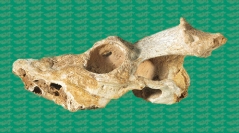

 Comptes Rendus Palevol
20 (9) - Pages 141-164
Comptes Rendus Palevol
20 (9) - Pages 141-164In the Pleistocene faunas of the island of Crete, Cervidae was one of the most abundant taxa. Respective species vary in body size, including dwarfs, and skeletal morphology; however, the number of species and the identity of the mainland ancestor(s) are still debated. In this paper, we morphologically and morphometrically describe and analyze eight skulls of Cretan deer from a so far little known fossil site near Gerani, Rethymnon, Greece. The recorded character suite allows for affiliation to dwarfed Candiacervus Kuss, 1975, Candiacervus ropalophorus de Vos, 1984 and C. reumeri van der Geer, 2018. It comprises previously unknown unique traits, some of them hinting to sexual dimorphism. Comparisons of the Candiacervus skulls presented here with those of cervids belonging to Megalocerotini Brooke, 1828, s.s. and s.l. stress certain similarities; yet more material is needed to reconstruct Candiacervus’ phylogenetic position. The newly detected craniodental specifics allow for more insights into island adaptation of Candiacervus; at the same time, they blur the morphological heritage of their mainland ancestors.
Candiacervus, craniodental morphology, morphometrics, island evolution